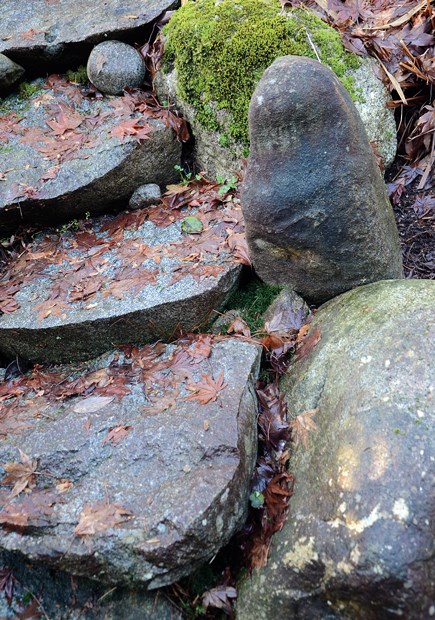Few gardeners have happily dug into earth without hitting a rock or two, and gardeners who live in mountainous regions know all too well that rocks are going to be part of the garden.
One rock is no problem as it can be buried or discarded. Many rocks are either a blessing or a curse depending on the type, quantity and size of rock present. More often than not, rocks can be used in the construction of the garden.
There are some really creative gardeners out there who recycle rock found onsite to build a variety of constructions. Retaining walls are the most common use for found rocks if you have enough large ones, which never seems to be the case. Then there are the bed edgers who surround their planting beds with found rock.
For small-sized rocks I have seen people make drains, spill ways, catchment areas or loose stone pathways. On steep slopes, small-sized rock can also be used as mulch to slow down rainfall runoff along stairs or walkways. Then there's the whole craft set of gardeners who find small quantities of rock with no purpose, so they fill up glassware with them or paint them for display.
Few people are probably aware of the value of adding rocks as a component of soil. It may seem a foreign concept to some people but adding rocks to soil can be beneficial for plants and soil micro-organisms. Whenever I am training students to build or amend planting beds I always tell them to retain any rock that is fistsized or smaller and remove any rock that is bigger than a fist. The purpose of selective stone retention during bedwork is to add mineral content to the soil. Plants are relentless rock breakers whether by direct action of root splitting or through the chemical action of their roots that break down the surface of rocks to glean off minerals.
One of the most common uses for found rocks is to build a rock garden. For purists, the traditional rock garden is a highly organized feature set prominently within the garden's overall design. They are built with a custom-designed soil mix, naturalistic layout of boulders and a structured layout of only alpine plants.
However, the average person is not a purist and usually does not care about such details. They just want a place to get rid of all those rocks.
For the average person who wants to build a normal rock garden there are several main factors to consider during design and construction. Firstly, choose a location that makes sense within the context of the site's topography. A rock garden sitting in the middle of flat lawn can look like a burial mound. Rock gardens sitting lost at the edge of the property look like neglected piles of rocks and weeds. Those built on steep slopes require specific preparation to assure there is no future risk of destabilization or collapse. On steep slopes set the rocks on granular material, which will provide stability and drainage, preventing water buildup behind the rocks.
Secondly, choose an aspect, or relationship to the sun, that is conducive to the type of plants to be grown. I am not a rock garden purist and many other plants besides alpines benefit from the warm atmosphere and free drainage that is provided by rock gardens. For example, many Mediterranean plants will enjoy the drainage of rock gardens while benefitting from the sun's warmth that is retained and released from the rocks.
Thirdly, choose rocks or boulders that are in harmony with the design of the house and the surrounding landscape. Nothing looks more out of place than one of those desert-style rock gardens or dry river beds filled with colourful shiny rocks imported from some exotic locale.
If you don't have enough rock to build the garden try buying some of our beautiful natural basalt from Squamish, available at local landscape supply yards. Basalt is not only natural for our area, it has a beautiful texture and a colour that changes with the weather.
When it comes to choosing plants for your rock garden, try to choose those with a mature size that is in harmony with the size of rock. Plants that grow too big will overpower and hide all those beautiful rocks. Plants that grow too small will be lost in the rock.
Plant and rock sizing should be chosen to attain visual balance between the hard and bulky looking rocks and the soft looking plants to create a harmonious design that will be engaging for your eyes, mind and soul.
Todd Major is a journeyman horticulturist, garden designer and builder, teacher and organic advocate. For advice contact him at [email protected].



